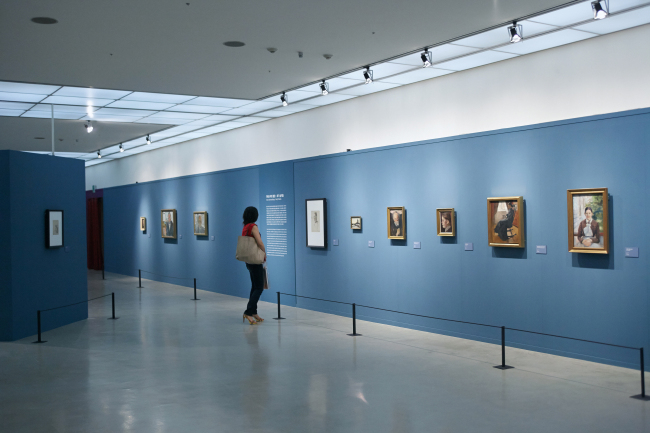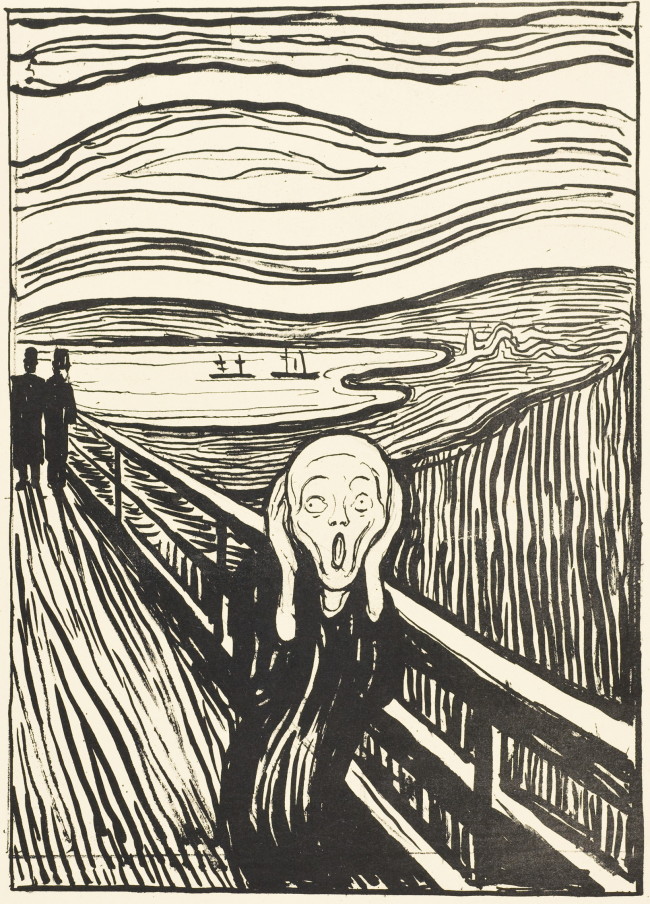Two metal detectors are installed in the lobby of the Seoul Arts Center and a sign stands near them, saying that sharp and blunt weapons, firearms and chemical substances and toxic chemicals are not allowed inside.
The heavy security measures are not in place for a presidential event, but they were instlled to protect the Edvard Munch exhibition currently in Seoul.
“We install metal detectors at every overseas Munch exhibition and also at the Munch Museum in Oslo,” said Trygve Lauritzen, head of security at Munch Museum, during the press preview of the Seoul exhibition. “Works of Edvard Munch are part of the Norwegian heritage and their value is enormous. That’s why we are strict on security.”
The most famous work by Munch, “The Scream,” was stolen twice in Oslo ― first at the National Gallery in 1994 and then a decade later at the Munch Museum. Since the two robberies, the museum has tightened security and approved only those overseas exhibitions that meet its heightened security requirements.
Lauritzen declined to discuss the details of the security requirements, but he said the Munch Museum still prohibits people from carrying objects such as knives and screwdrivers into the museum.
“Metal detectors prevent 99 percent of what could happen,” he said. Lauritzen added that about 40 percent of outside exhibitions have been canceled because they don’t meet security requirements.
 |
A visitor browses the Edvard Munch exhibition at the Seoul Arts Center. |
 |
“Madonna” by Edvard Munch (Munch Museum/ Munch-Ellingsen Group/BONO, Oslo 2014) |
The tight security doesn’t affect the Seoul exhibition visibly, though. The inside looks like any other exhibition, with 99 original works of Edvard Munch on display, including the two most famous works, “The Scream” and “Madonna.” Munch made four different versions of “The Scream” in oil, tempera, crayon and pastels. The pastel composition sold for a record amount of some $119 million at Sotheby’s in New York in 2012.
According to Culture and I Leaders, the Korean art agency organizing the exhibition, “The Scream” painting does not travel abroad for exhibitions any longer ever since two robberies occurred in 1994 and 2004. Instead, a 1895 black-and-white lithograph version arrived in Seoul for the first time. The lithograph was first revealed overseas at the Museum of Modern Art in New York in 2006.
 |
“The Scream” by Edvard Munch (Munch Museum/Munch-Ellingsen Group/BONO, Oslo 2014) |
The exhibition hall is kept around 21 degrees Celsius with a humidity of 48 percent throughout the exhibition period to prevent potential damage from the environment. The humidity can reach as high as 80 to 90 percent during summer in Korea.
“Fragile works need a stable environment,” said Stein Olav Henrichsen, director of the Munch Museum.
Taking masterpieces of the renowned artist from their home in Oslo is not an easy process. It took three years to examine the museum, make improvements in its settings and conduct conservation work on the paintings to prepare them for travel.
“(The) works are very fragile (and) we have to do conservation work on every painting using different treatments,” he said. The director said museum conservation staff applies special adhesives including sturgeon glue to the back of the canvases to prevent the oil paints applied on top from moving during travel.
Henrichsen explained that sometimes lacquer is applied to the surface of paintings by other artists such as Vincent Van Gogh in order to give a furnished look, but the Munch Museum never applies anything on top to maintain the “raw, naked and direct” feeling of Munch’s paintings.
The exhibition “Edvard Munch and the Modern Soul” will continue through Oct. 12 at the Seoul Arts Center in Seocho-gu, Seoul. The admission fee is 15,000 won for adults, 12,000 won for teenagers and 10,000 for children under 12. For more information, visit www.munchseoul.com.
By Lee Woo-young (
wylee@heraldcorp.com)






![[Today’s K-pop] Blackpink’s Jennie, Lisa invited to Coachella as solo acts](http://res.heraldm.com/phpwas/restmb_idxmake.php?idx=644&simg=/content/image/2024/11/21/20241121050099_0.jpg)



